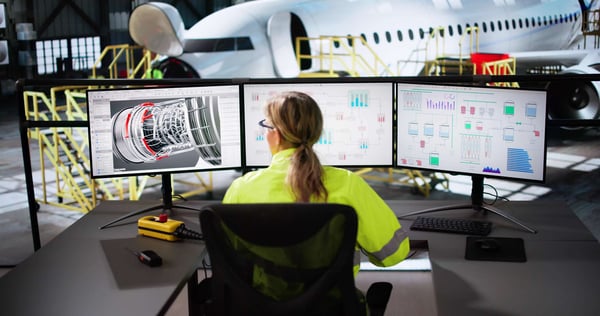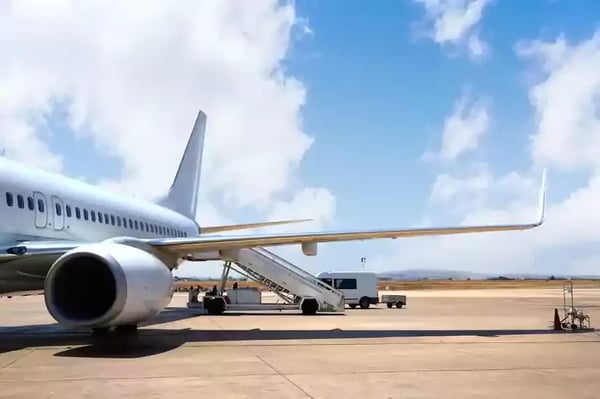These days, whatever technologies might be available for airlines and MROs, the bottom line is the bottom line. Businesses have to make a profit, to achieve which they have to create efficiency and now digitalization can actually help in creating that efficiency. That’s going to be the topic of this White Paper. I’d like to start by getting an insight into where we are in the industry at the moment as well as how those new technologies can help to improve quality in an organization but also provide a better work environment for all staff in the business. We’ll run through the basics and generate some urgency about what is happening in the aviation industry. There will also be some key examples of where there is much focus as well as developments going on and how, to date, we have seen many implementations in the industry that really helped create and improve overall efficiency.
If you'd like to read more articles about MRO software, take a look at these:
- Everything you need to know about MRO Software
- Key functionalities of aircraft maintenance software
- Synchronising MRO software with airline ERP platforms
- 5 Things You Need to Look for in MRO Software
- MRO Meaning in Aviation
- Choosing the best MRO Software
Digital transformation in aviation
To give you a bit of background, QOCO is a software company, and while we provide software for our customers, we also try to partner with them as much as possible. It’s not just about delivering a software solution; we also
help organizations improve how they work and see how they can adapt to and leverage new technologies. Founded in 2009, QOCO already has more than 50 airline and MRO customers around the world where we have
successfully helped to transform their way of working into a digital environment.
Looking at the background, everybody in the industry knows that there has been a huge increase in the number of flights. Aircraft numbers are also picking up with lots of new deliveries. However, if you look from a staffing perspective, the development looks different (figure 1).

Figure 1
“…within the next 20 years, the expectation is that there will be manpower shortages amounting to 600,000 mechanics and that cannot be covered from school leavers alone.”
Boeing has published its Pilot and Technician Outlook 2022-2041 concluding that, within the next 20 years, the expectation is that there will be manpower shortages amounting to 600,000 mechanics and that cannot be covered from school leavers alone. We need more ways in which to improve recruitment and to be able to cope with the gap because of the growing numbers of aircraft arriving in the industry. That will mean increasing levels of competition for staff, which will be a really big concern. From an industry perspective, we need to take steps in the coming years to identify the gaps and to work on the next actions.
How Digital Solutions Improve Efficiency in MRO
One of the key strategies when working with digital or becoming a digital organization is involving employees in the transformation. They’ll want to work in a more digital environment because nowadays, everybody is so technology-driven; they use mobile devices for all kinds of solutions at home, whereas, within the industry, the main focus is still on a paper-based or manual way of working.
So, if you become a more digitized organization, you become a more attractive employment option for new people coming from schools and entering the job market where aviation has to compete with other industries. More and more, it’s about salaries, obviously; however, only a certain amount can be done in aviation to increase salaries or attract staff. So, you need to find other ways to distinguish your company to attract more people to come and work in the aircraft maintenance sector.
It’s about connecting with staff and encouraging them to take part in any developments and to become more technology savvy to relate to the technologies of today and tomorrow increasingly. Implementing a digital way of working is about laying the foundations for digitization (figure 2). If you’re just trying to adapt from paper-based ways of working, you may simply be adapting to chaos.
Want to explore more about MRO software and its key functionalities? Read our complete guide on everything you need to know about MRO software to gain further insights.

Figure 2
You really need to make sure that, when undertaking a digital transformation, you take into account, ‘How can these new digital tools directly help to improve efficiency’? Some companies claim to have become digital, but becoming digital is not just putting paper documents into Excel; it’s really about putting all of the data into the system in the correct place so that you have the proper information available to access and use in real-time. Having the data, you will be able to be increasingly efficient and allocate staff to tasks with proper timing because, quite often, there’s a mismatch between when staff are available versus the actual work being done or when the aircraft comes in. There are so many changes going back and forth in the schedules that it’s increasingly important to align tools so that you have more insight and can create efficiency.
Optimize your technical workforce with MROTools.io Assignment
“…everybody is so technology driven; they use mobile devices for all kinds of solutions at home whereas,
within the industry, the main focus is still on a paper-based or manual way of working”
As well as having the data, there have been discussions about machine learning. Data driven decision making requires a different mindset for people who are working as planners. Planners can no longer simply base their decisions on experience; it’s also about adapting to new ways of working, understanding how those data functionalities work, how they can be interpreted. Increasing numbers of planners and engineers need to become like data scientists; understanding the data and making decisions based on data or facts instead of basing them on 20- or 30-years’ experience of how things were in the past.
Finally, one of the stronger arguments for digitization is the contribution to sustainability which is becoming a key issue and a really important topic in the industry. So, by becoming more digitized, as well as working efficiently, you’re also providing more benefits towards the sustainable environment and towards a sustainable organization.
“Data driven decision making requires a different mindset for people who are working as planners. Planners can no longer simply base their decisions on experience; it’s also about adapting to new ways of working, understanding how those data functionalities work, how they can be interpreted.”
Digitization: The key to overcoming workforce shortages
Today, there is a lot of focus on highlighting your digital transformation initiatives for the board and for executives as part of a business case and getting sufficient funding to buy digital applications. However, what we quite often see is that organizations tend to forget to discuss their plans with the actual people who will have to work with the changes who need to use, for instance, mobile digital solutions.
Some mechanics might have been working with a paper-based system for twenty years and, suddenly, they are given an iPad and told that ‘here’s a mobile device and an electronic logbook; now get on working with it’. It’s so important that management work on gaining acceptance of any new solution from the staff. It’s important to have staff work increasingly digitally and to be familiar with the digital applications so that they will actually like working rather than them stressing about only the amount of effort and the administration involved in certain digital solutions.
Something that we often forget is that everybody’s so busy that we’re running from one project to another. Sometimes, when we hear from an organization that they want to implement a digitalization project, they say, ‘we want the digital solution but we still have twenty other projects on which we are working’. Quite often, an organization will be struggling to manage all of the projects one after the other.
All that said however, we tend to forget to celebrate what has been achieved, to let the people, the staff, know what they have done and what we have achieved together and what the benefits have been so that they can see the positive side and experience a positive attitude instead of just being pushed all of the time with new applications, eventually becoming frustrated and then leaving to join another company.
Case studies: Digital innovation in MRO
There have been a lot of projects implemented that have seen that a digital signature, from a technology perspective, might seem to be the solution; digitize the signature and that’s it. However, when you properly implement a digital signature solution, it allows you to completely digitalize the process; you can do much more than just create a digital signature. You can build in safety blocks, and can take out all of the repetitive tasks required to do checking and verification of information.
Then you will really see a window of opportunity opening up where you can do so much more with digitization, including relieving the pressure off mechanics and off planners because the challenge isn’t only for retention of mechanics at the moment; more and more logistical people in the industry are leaving to join Amazon and similar businesses because they also need logistical people. If aviation is to retain these skilled and experienced people, it’s about really making their work life easier and more attractive.
Another example, while not particularly about digital ways of working, is a better way of working that we have implemented in a number of airlines in Europe. It’s like the Formula 1 concept that you have all the materials, all the
tooling available where the work needs to be done and that the mechanics can do all the work, on the aircraft using a mobile device so that they can see how easy it is, that they can work with an iPad, don’t have to walk back and forth to the stores, and that they don’t have to wait. They can deal with the actual repairing of the aircraft, which is what they most want to do, instead of waiting and having to do loads of administration and duplicated activities.

A further example is automated planning because, for example, planning includes some repetitive actions in as much as each day planners assign people, each day they check technicians’ qualifications and skills before assigning them to a job whereas there are solutions that can automate planning based on skills rules. It’s not completely like machine learning, it’s more like an automation with which the system can handle all of those repetitive tasks. It can eventually save up to four or five hours a day instead of doing all the calculation, the preparation, collecting all the manpower, uploading it into the system and adjusting because the schedule keeps on changing.
You take out increasing numbers of repetitive tasks for the personnel and make it more attractive so that they can focus on new projects such as the MRO solution of using drones for aircraft inspections. It’s not about taking away the mechanic, we still need them, but it’s about providing them with better tools that make the work more attractive and, in return, you will have a more efficient and quicker turnaround of your aircraft repairs.
.jpg?width=2309&height=1299&name=iStock-1401444200%20(1).jpg)
Looking at a very specific case, a couple of years ago, an airline customer implemented drone inspections for lightning strikes. As readers will know, when an aircraft is struck by lightning, it needs to go to the hangar for inspection. To make the inspection, you need a high loader, and because you’re looking for a needle in a haystack, an inspection can take from eight up to 12 hours without administration. It’s just basically going over the aircraft and finding any damage, which will require three to four mechanics to carry out the work.
By contrast, using a drone equipped with machine learning, the inspection can be completed in 45 minutes, reducing the downtime by at least seven hours and only needing one mechanic who can do everything in two hours. We are also developing the machine learning model which is essentially like a new employee. But to start with, you need a lot of data before it becomes reliable. More and more now it has become so reliable that you can, in one to two hours, do a full inspection, including administration, of an aircraft that has had a lightning strike; saving ten hours of ground time which would cost 30 to 40 mechanics man hours as well as delay compensation payments to passengers and more.
Furthermore, we are working on a project for efficient tool management: A-checks usually need about eight and a half or nine hours ground time whereas we can reduce that to one hour ground time by creating efficiency, having the tool and digital administration. For the airline where we have implemented this, there are about 350 A-checks a year so that means a considerable manpower saving.
Implementation roadmap for digital solutions
In terms of an implementation roadmap, with big projects, we quite often see bold ambitions and a wish to start as quickly as possible. However, we have realized nowadays that because there are so many changes going on, it’s really important to create a step-by-step implementation roadmap.
Focus on the first step of getting the basics right, getting the organization to understand what is going on and how they can adapt to the first phases instead of just going live and, within a few days, expect everything to work; that’s really not what happens.
Involve the mechanics in assessing where the pain points are and how you can improve efficiency; then keep them involved in each step of the project as subject matter experts rather than only considering the management
perspective.
Roll out the digital initiatives gradually, monitoring progress and seeing how you can adapt, and a lot of new opportunities will be revealed, plus your processes will become more and more suitable for the actual needs.
“Involve the mechanics in assessing where the pain points are and how you can improve efficiency and
keep them involved in each step of the project as subject matter experts rather than only considering the management perspective.”
CONCLUSION
In conclusion, I’d like to emphasize that it’s really important to work on digitization because there are more and more discussions with labor agreements with unions, so you need to be able to become more flexible to provide better services to cope with the challenges facing the industry at the moment. A lot of organizations are undertaking changes and digitization on an independent level. As an industry in general, we need to work more together, share information, share knowledge, have more organizations involved, and work with schools and
colleges as well as with authorities who are increasingly helping us to allow this digital way of working. We need a fundamental change throughout the industry because eventually, as you have seen, we could run out of mechanics. Then we would have a lot of new aircraft but not have the staff to maintain them or properly do all the work.
The adoption of digital solutions in MRO is just one piece of the puzzle when it comes to optimizing aircraft maintenance operations. From mobile accessibility and AI-driven analytics to seamless ERP integration, modern MRO software is evolving to meet the industry's dynamic needs.
If you’re looking for a comprehensive breakdown of how MRO software is transforming aviation maintenance, don’t miss our article: Everything You Need to Know About MRO Software



 Remon Sweers
Remon Sweers
 If you are interested in knowing how you can improve your efficiency in maintenance operations, book a 30-minutes discovery call with us.
If you are interested in knowing how you can improve your efficiency in maintenance operations, book a 30-minutes discovery call with us.

